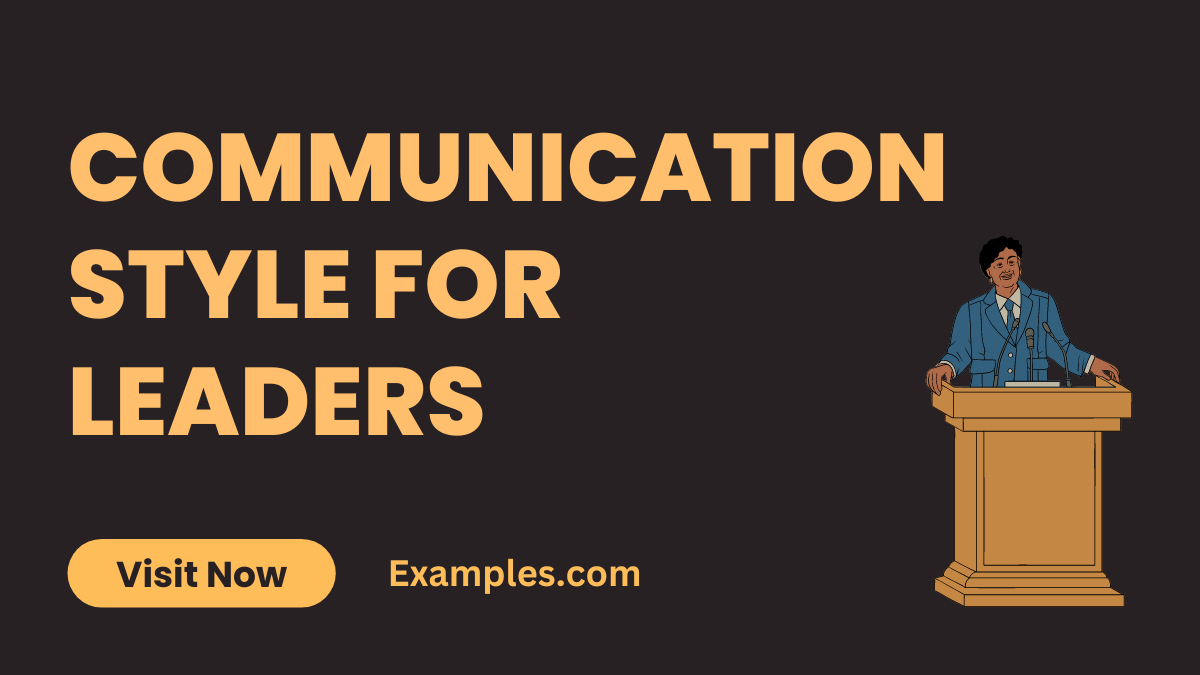9+ Communication Style for Leaders
Embark on a transformative journey as we delve into the comprehensive guide on “Communication Style for Leaders .” Unravel the intricacies of effective leadership communication, exploring key examples that illuminate the path to stronger connections. From decoding signals to implementing practical solutions, this guide is your compass for navigating the dynamic landscape of interpersonal relationships. Elevate your understanding and refine your communication style, shaping a future of harmonious connections. Let’s navigate the nuances together, starting with impactful “Communication Examples.
Download Communication Style for Leaders in PDF
What is Communication Style for Leaders?

Communication Style for Leaders refers to the distinctive manner in which leaders express themselves and interact with others. It encapsulates the tone, language, and approach leaders employ to convey information, inspire, and guide their teams. In simple terms, it is the personalized way leaders communicate, reflecting their personality, values, and leadership philosophy. Understanding and honing this style is pivotal for effective leadership, fostering clearer understanding and collaboration within the organizational framework.
10 Examples Of Communication Style For Leaders In Examples

Exploring various Communication Styles for Leaders through 10 unique examples unveils the nuanced ways leaders interact. From the Director’s assertive guidance to the Expresser’s emotive approach, each style shapes organizational dynamics.
- Director: Offers precise instructions but might overlook team input. Encourage open discussions to balance direction and collaboration.
- Expresser: Emphasizes emotions, potentially overwhelming. Balance emotions with facts for a more rounded impact.
- Harmonizer: Prioritizes team harmony but may avoid conflict. Foster a safe space for constructive disagreements to promote growth.
- Thinker: Focuses on analysis, risking overthinking. Encourage timely decisions to channel critical thinking effectively.
- Adaptive Leader: Flexibility is their forte, but inconsistency can arise. Establish adaptable frameworks for consistent adaptability.
- Transparent Leader: Strives for openness, risking oversharing. Maintain relevance in transparency to avoid information overload.
- Authoritative Communicator: Instills confidence but may seem dominating. Foster a participative environment to complement authority.
- Inspirational Leader: Inspires but might lack practicality. Infuse inspiration with actionable steps for tangible progress.
- Strategic Communicator: Focuses on the big picture, potentially neglecting details. Combine strategy with attention to essential particulars.
- Effective Leader: Balances multiple styles effectively. Continuously refine adaptability to suit diverse scenarios.
Communication Style for Leaders in the Workplace
Embarking on effective leadership communication is pivotal for a thriving workplace. Leaders wield various communication styles, such as directive or supportive, tailoring their approach to guide teams towards success. Understanding these styles is essential for effective leadership. In this context, exploring communication styles for influencers and communication styles for students offers valuable insights for adapting leadership strategies to different contexts.
- Understanding the Dynamics: Leadership communication in the workplace involves conveying ideas, directives, and feedback effectively. It sets the tone for organizational culture, team dynamics, and overall productivity.
- Tailoring Your Approach: Adapting your communication style to different workplace scenarios is crucial. Whether addressing a team meeting, providing constructive feedback, or navigating conflicts, leaders must tailor their approach to suit the context.
- The Impact on Relationships: Effective communication enhances relationships among team members and between leaders and subordinates. It fosters trust, transparency, and a sense of unity, contributing to a positive and collaborative work environment.
- Recognizing Different Styles: Leadership communication styles vary. Some leaders may adopt a directive approach, while others may prioritize a more collaborative or participatory style. Recognizing and understanding these differences is key to effective communication.
- Balancing Authority and Approachability: Leaders need to strike a balance between being authoritative and approachable. While asserting authority is essential for decision-making, approachability fosters open communication, idea-sharing, and a sense of camaraderie.
- Addressing Challenges: Communication challenges may arise, such as misunderstandings, misinterpretations, or conflicts. Leaders should proactively address these challenges through clear communication, active listening, and prompt resolution.
Communication Style For Leaders For Strengths And Weaknesses
Understanding the strengths and weaknesses of various communication styles is pivotal for effective leadership. Leaders adept in manipulative communication or open communication can leverage strengths and address limitations for impactful interactions.
- Director Style: Strengths lie in clarity and decisiveness, yet it may overlook team input, resulting in reduced collaboration. Weaknesses: Overemphasis on directives might hinder innovation and suppress team creativity.
- Expresser Style: Emphasizes emotions, fostering strong connections, but an overreliance may cloud logical decision-making. Weaknesses: Potential overwhelm with emotions might obscure critical information.
- Harmonizer Style: Prioritizes team harmony, yet excessive avoidance of conflict may hinder progress and innovative ideas. Weaknesses: Conflict avoidance might suppress necessary discussions for growth.
- Thinker Style: Analytical and detail-oriented, but excessive analysis may lead to overthinking and delayed decisions. Weaknesses: Overemphasis on analysis might stall progress and deter timely actions.
How to Improve Leadership Communication Skills
By adopting these strategies, leaders can continuously improve their communication skills, fostering a positive work environment and promoting a culture of open collaboration. Explore further insights into communication styles in leadership and identify the most desirable style of communication for your leadership context.
- Understand Your Audience: Tailor your communication style to resonate with your audience, considering their preferences, knowledge level, and expectations.
- Active Listening: Cultivate the art of active listening. Acknowledge and respond to your team’s concerns, demonstrating empathy and understanding.
- Clarity and Conciseness: Communicate with clarity and conciseness. Avoid unnecessary jargon and articulate your message in a straightforward manner.
- Adaptability: Be adaptable in your communication style. Different situations may require different approaches; flexibility is key.
- Encourage Open Dialogue: Foster an environment where team members feel comfortable expressing their thoughts. Encourage open dialogue to promote collaboration.
- Provide Constructive Feedback: Deliver feedback constructively, highlighting both strengths and areas for improvement. Create a culture of continuous learning.
- Lead by Example: Demonstrate the communication style you expect from your team. Model effective communication in your interactions.
- Utilize Technology: Leverage communication tools and technology to streamline processes and enhance the flow of information within the team.
- Establish Clear Communication Channels: Define clear communication channels to prevent misunderstandings. Establish guidelines for different types of communication.
- Invest in Training and Development: Enroll in leadership communication training programs to further hone your skills. Continuous learning enhances your ability to lead effectively.
What leadership style is best for communication?
Adaptive leadership style is best for communication. It allows leaders to tailor their approach, ensuring effective interaction across diverse teams and situations.
What is Best Mode of Communication for a Leader
The best mode is a mix of direct and transparent communication. Leaders should employ face-to-face interactions, virtual meetings, and written communication for optimal results.
Why are communication styles important in leadership?
Communication styles shape a leader’s impact. They influence team dynamics, morale, and organizational success. A thoughtful approach fosters understanding, collaboration, and a positive work culture.
In conclusion, mastering diverse communication styles is pivotal for effective leadership. From inspiring visionary communication to diplomatic collaboration, each style shapes organizational dynamics. Recognizing the signs and understanding the effects allows leaders to proactively address challenges. Explore further insights into communication styles in relationships and communication styles in the workplace to foster positive connections and enhance leadership impact.



